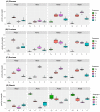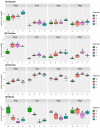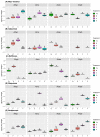Identification of Factors Linked to Higher Water-Deficit Stress Tolerance in Amaranthus hypochondriacus Compared to Other Grain Amaranths and A. hybridus, Their Shared Ancestor
- PMID: 31336665
- PMCID: PMC6681232
- DOI: 10.3390/plants8070239
Identification of Factors Linked to Higher Water-Deficit Stress Tolerance in Amaranthus hypochondriacus Compared to Other Grain Amaranths and A. hybridus, Their Shared Ancestor
Abstract
Water deficit stress (WDS)-tolerance in grain amaranths (Amaranthus hypochondriacus, A. cruentus and A. caudatus), and A. hybridus, their presumed shared ancestor, was examined. A. hypochondriacus was the most WDS-tolerant species, a trait that correlated with an enhanced osmotic adjustment (OA), a stronger expression of abscisic acid (ABA) marker genes and a more robust sugar starvation response (SSR). Superior OA was supported by higher basal hexose (Hex) levels and high Hex/sucrose (Suc) ratios in A. hypochondriacus roots, which were further increased during WDS. This coincided with increased invertase, amylase and sucrose synthase activities and a strong depletion of the starch reserves in leaves and roots. The OA was complemented by the higher accumulation of proline, raffinose, and other probable raffinose-family oligosaccharides of unknown structure in leaves and/or roots. The latter coincided with a stronger expression of Galactinol synthase 1 and Raffinose synthase in leaves. Increased SnRK1 activity and expression levels of the class II AhTPS9 and AhTPS11 trehalose phosphate synthase genes, recognized as part of the SSR network in Arabidopsis, were induced in roots of stressed A. hypochondriacus. It is concluded that these physiological modifications improved WDS in A. hypochondriacus by raising its water use efficiency.
Keywords: Abscisic acid; grain amaranth; osmotic adjustment; sucrolytic enzymes; sugar starvation response; water-deficit stress tolerance.
Conflict of interest statement
The authors declare no conflict of interest.
Figures















References
-
- Bhargava S., Sawant K. Drought stress adaptation: Metabolic adjustment and regulation of gene expression. Plant Breed. 2013;132:21–32. doi: 10.1111/pbr.12004. - DOI
Grants and funding
LinkOut - more resources
Full Text Sources

